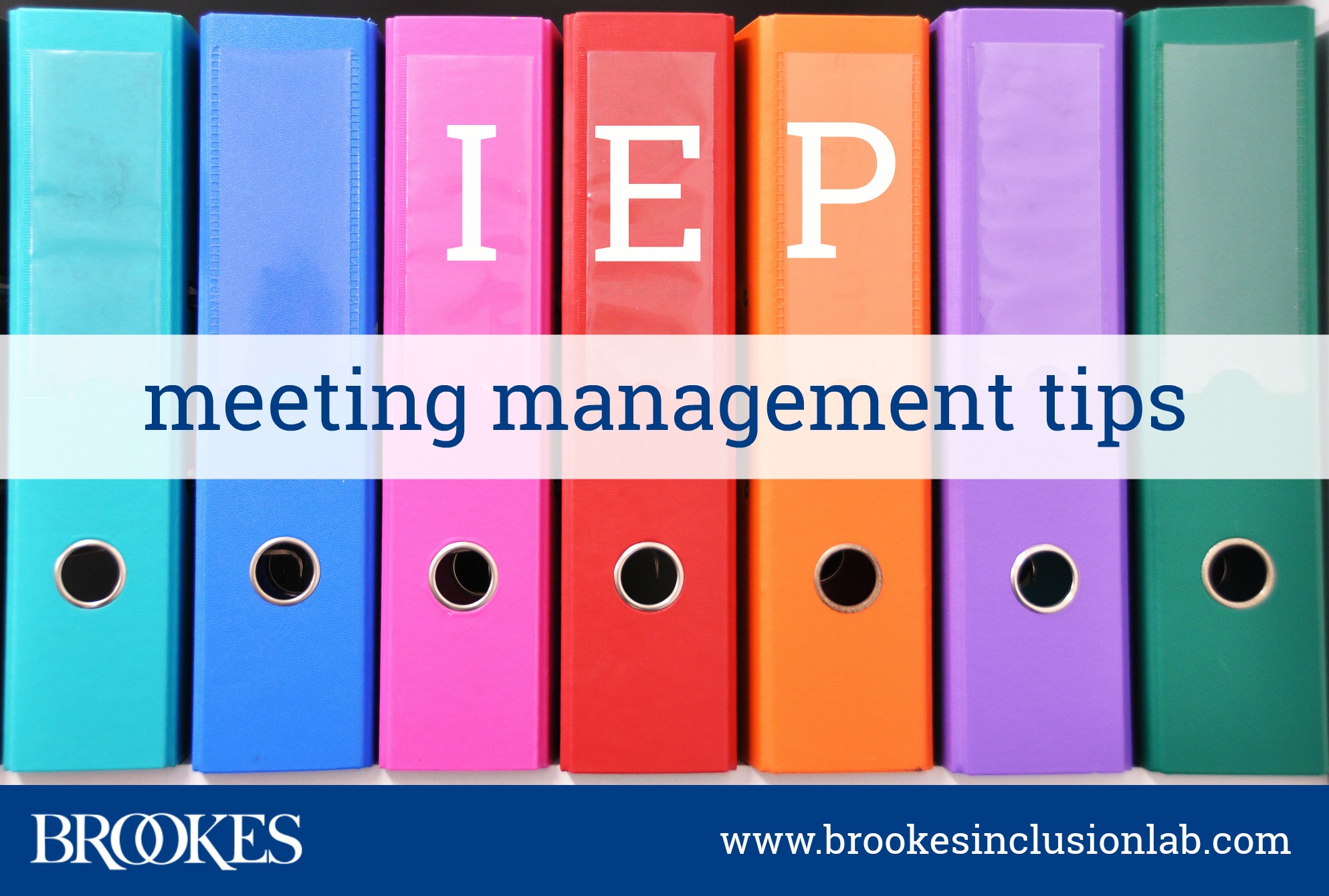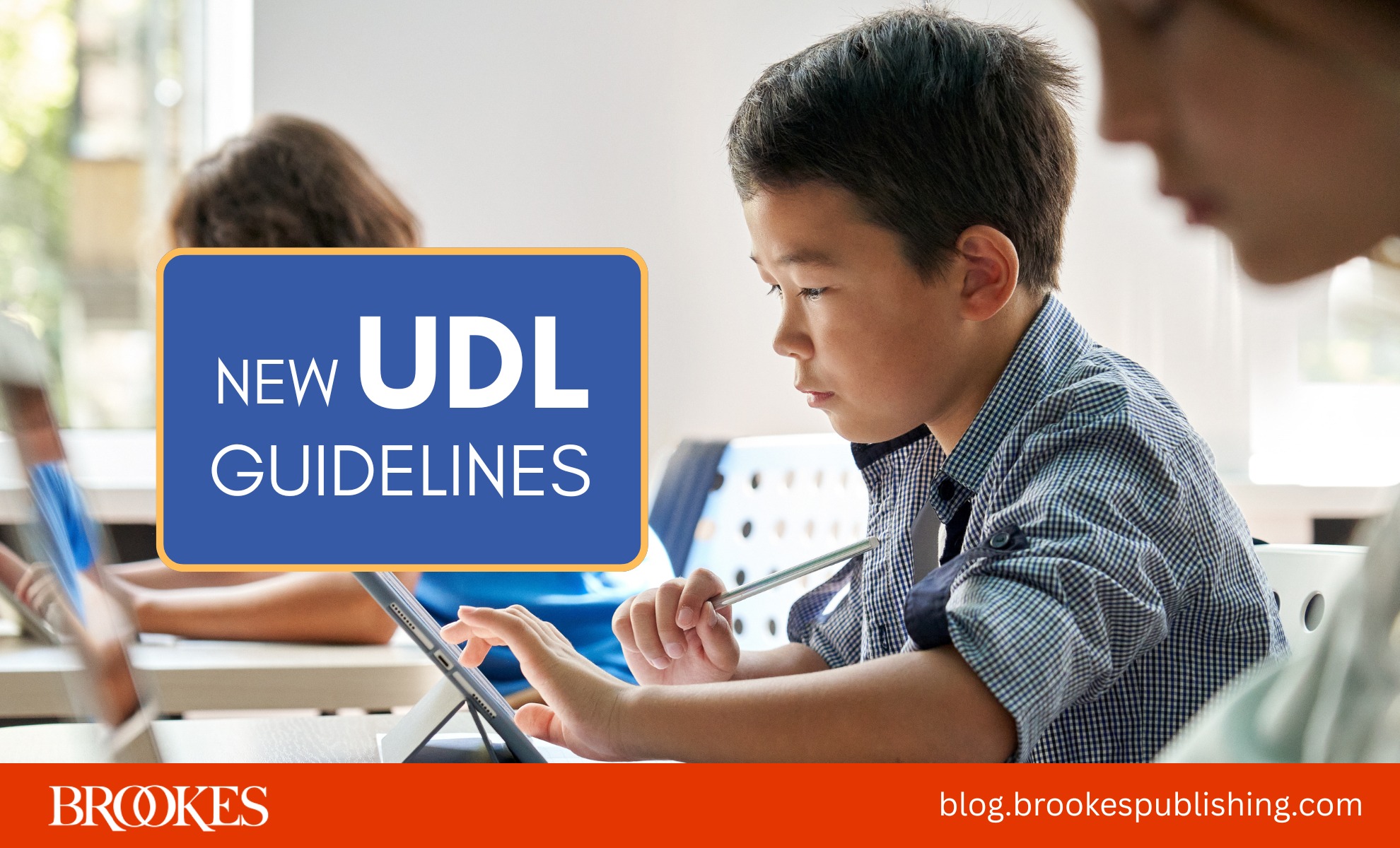14 Tips on Organizing and Managing an IEP Meeting
April 20, 2021
With so much at stake, IEP meetings can often feel stressful for everyone involved. But if a meeting is well-planned, well-organized, and skillfully managed, chances are good that the team members will feel reassured, respected, and ready to collaborate.
As schools resume face-to-face learning and in-person meetings—whether now or in the fall—how can you plan and manage IEP meetings while juggling all your other tasks? Today’s post, excerpted and adapted from several Brookes books, offers you some practical tips on getting organized before the IEP meeting, keeping it on track, and following up later. While it’s not a complete guide to organizing and managing an IEP meeting, it’s a good collection of reminders you can use to smooth out some of the bumps in the road. (For more in-depth information, see the books at the end of this blog post.)
Create a checklist of tasks. If you’re a teacher in an inclusive classroom, you might be juggling several different IEP meetings during the same month. To keep track of your progress and be sure no detail falls through the cracks, create a checklist of all the tasks involved in preparing for an IEP meeting. Include checkboxes so you can easily cross things off when you complete them and know what you need to do next. Clip your checklist to a pocket folder so you can keep all your documents in one place. You can also copy the completed checklist and put it in the mailboxes of staff members who have tasks to complete (highlight the tasks they’re responsible for).
Prepare and support your student ahead of time. If your student will be participating in or even leading their own IEP meeting, confer with them in advance to offer support. Go over the key concepts and parts of IEP meetings, clarify how IEP meetings will help them set and work toward goals, role-play a meeting to help calm their nerves, and help them prepare any materials they may need. The meeting will go much more smoothly if your student feels well prepared. (For more tips, see this blog post on 9 First Steps to Student-Directed IEPs.)
Involve your student in the planning process. Your students can help you stay on track by assuming responsibility for some of the tasks on your checklist. For example, depending on their skills. they might help with scheduling the meeting time and place, deciding who to invite to the meeting, sending out invitations, preparing nametags, setting up audiovisual or other equipment, and preparing questions for participants.
Make your agenda easy to access. Once you’ve come up with an agenda for the meeting, make copies of it for every member of the committee and distribute them. This will help keep the meeting moving and ensure that everyone stays on track. Include space for note-taking, and consider writing a pared-down version of the agenda on a whiteboard or easel that everyone can easily see and follow. (A simplified written or picture-based outline of the meeting might also be a helpful thing to provide for your student, so they know what to expect during each section.)
Send reminder notes. Have you have ever been in an IEP meeting where an important member of the team forgot to show up? With everyone’s schedule so packed these days, almost everybody needs a little reminder now and then. Send brief notices or emails to your team members to remind them of the date, time, and location of the meeting, plus the tasks they need to complete or materials they should prepare before the meeting. (Have your student help compose and send these reminders if possible.)
Compile a packet for each participant. Put together a well-organized folder for each meeting attendee. Include copies of all relevant reports, assessments, IEPs, and material that you’ll discuss in the meeting. Blank paper and pens for each participant will help your team members organize their thoughts and take good notes during the meeting.
Keep important forms at your fingertips. Prepare a separate folder with any additional forms you might need in a pinch. You might include extra copies of your form for taking minutes, the parental rights form, a permission to evaluate form, and the permission to release confidential information form.
Bring snacks and drinks. This might seem like a small thing, but snacks are an important item on your IEP must-have list. A parent or professional who’s rushing to the meeting from a class or home may not have had a chance to eat yet, and hungry people tend not to think very clearly. To promote a positive atmosphere from the start, put out some simple snack items, a few bowls of individually wrapped candies, and some bottled juices or waters—these are inexpensive and will be very much appreciated by your team members. Not only will your snack spread add to a sense of warmth and welcome, it may also reduce the number of times that meeting participants feel a need to take a break.
Use a projector. If you have access to a projector and screen, make use of it! When team members can watch as you type in new goals and objectives, it’ll be easier for everyone to understand the changes—and it facilitates participation at the meeting, too. You’ll be much less likely to receive questions and comments from confused team members later if everyone can watch the changes being implemented on the spot.
Work out tech issues in advance. Many of us have been to a meeting that started ten or fifteen minutes late because of issues with a laptop or a projector. If you’re using any equipment, plan to be at the meeting (or have someone else there) about 30 minutes early to set everything up, test it, and organize the room. And always have a back-up plan: come with paper copies of the IEP just in case your equipment fails when you least expect it.
Build in breaks. When team members walk out of the room without saying why they’re leaving or when they’ll be back, this can disrupt the meeting and undermine its efficiency. If your meeting is likely to be a long one (more than an hour), then pre-schedule a 5- or 10-minute break at a specific time and announce it up front. This way, your team members can answer any urgent text messages, use the restroom, and stretch their legs without having to leave in the middle of the meeting and miss important information.
Keep the team on task. Even the best-planned and most organized IEP meeting can be derailed by tangents and side conversations. Set ground rules about staying on task, and when conversational detours arise, gently remind the team of the rules you agreed on. You might say, “excuse me, team, we agreed earlier that we’d do our best to stay on task, knowing that our time is very limited today. How are we doing with that so far?” You could also give them a reminder by expressing your own feelings and observations: “I wonder if we may be getting a little off task right now,” or “Team, I’m feeling a little concerned as I watch the time go by and see how much is still on our agenda for today.”
Make a log of questions. This is a good way to keep a meeting on track and prevent tangents from taking over. As you encounter questions and issues that should be addressed down the road or outside the meeting, make a log of them so they don’t get lost. This written “parking lot” will ensure that issues are followed up on in a timely manner and important concerns don’t slip through the cracks.
Follow up. To be sure there were no loose ends or unresolved issues, make some sort of outreach after the IEP meeting, either later in the day or a few days later. You might ask your team questions like, “How do you think the meeting went? Did you feel heard and included? Anything you didn’t get a chance to say? Any thoughts or suggestions?” You may not need or have time for extensive followup after every meeting, but it’s important to maintain an open door for contact between meetings if and when team members need your help.
IEP meetings might come at the end of a long and exhausting day, but if you prepare well in advance, you’ll project confidence and competence even if you feel worn out. Use these tips before your next IEP meeting—and for more practical guidance, check out the books these tips were adapted from:
Tips 1, 4, 5, 6, 7, 9, and 10 adapted from The Special Educator’s Toolkit by Cindy Golden, Ed.D.
Tips 2 and 3 adapted from Getting the Most Out of IEPs by Colleen Thoma and Paul Wehman
Tips 8, 11, 12, 13, 14 adapted from A Guide to Collaboration for IEP Teams by Nicholas R.M. Martin, M.A.




Write a Comment
Your email address will not be published. Required fields are marked *
Post a Comment